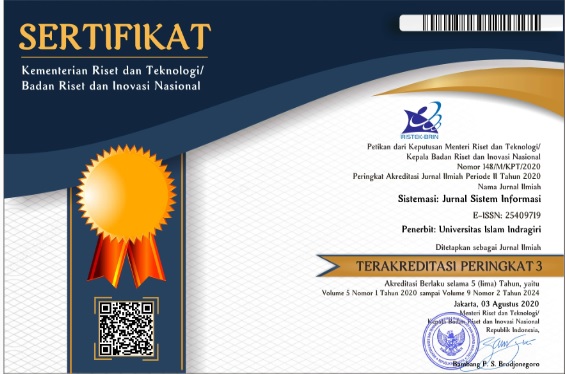A Comparative Study of Machine Learning Algorithms for Intrusion Detection Systems using the NSL-KDD Dataset
Abstract
Keywords
Full Text:
PDFReferences
B. Dhanunjay, E. Sanjay, A. K. Raj, and M. Dholvan, “Intrusion Detection System using Machine Learning,” Quantum Comput. Model. Cybersecurity Wirel. Commun., Vol. 6, No. 3, pp. 279–292, 2020, doi: 10.1002/9781394271429.ch19.
P. Dini, A. Elhanashi, A. Begni, S. Saponara, Q. Zheng, and K. Gasmi, “Overview on Intrusion Detection Systems Design Exploiting Machine Learning for Networking Cybersecurity,” Appl. Sci., Vol. 13, No. 13, 2023, doi: 10.3390/app13137507.
Amarudin, Styawati, Syaifuddin, and M. Iqbal, “Improving Intrusion Detection System on Servers using Machine Learning-Based RFERF Technique,” Proceeding 2024 9th Int. Conf. Inf. Technol. Digit. Appl. ICITDA 2024, pp. 1–8, 2024, doi: 10.1109/ICITDA64560.2024.10809789.
K. N. Jaya Varshini R, Sifa Thahasin F, Jayasri S, “Intrusion Detection System using Machine Learning Algorithm,” Quantum Comput. Model. Cybersecurity Wirel. Commun., pp. 279–292, 2023, doi: 10.1002/9781394271429.ch19.
A. Efe and İ. N. Abaci, “Comparison of the Host based Intrusion Detection Systems and Network Based Intrusion Detection Systems,” Celal Bayar Üniversitesi Fen Bilim. Derg., Vol. 18, No. 1, pp. 23–32, 2022, doi: 10.18466/cbayarfbe.832533.
A. Elhanashi, K. Gasmi, A. Begni, P. Dini, Q. Zheng, and S. Saponara, “Machine Learning Techniques for Anomaly-based Detection System on CSE-CIC-IDS2018 Dataset,” Lect. Notes Electr. Eng., vol. 1036 LNEE, No. April, pp. 131–140, 2023, doi: 10.1007/978-3-031-30333-3_17.
Amarudin, R. Ferdiana, and Widyawan, “B-DT Model: A Derivative Ensemble Method to Improve Performance of Intrusion Detection System,” J. Adv. Inf. Technol., Vol. 15, No. 1, pp. 87–103, 2024, doi: 10.12720/jait.15.1.87-103.
A. Lama and D. P. Savant, “Network-based Intrusion Detection Systems using Machine Learning Algorithms,” Int. J. Eng. Appl. Sci. Technol., Vol. 6, No. 11, pp. 145–155, 2022, doi: 10.33564/ijeast.2022.v06i11.028.
O. D. Okey et al., “BoostedEnML: Efficient Technique for Detecting Cyberattacks in IoT Systems using Boosted Ensemble Machine Learning,” Sensors, Vol. 22, No. 19, pp. 1–26, 2022, doi: 10.3390/s22197409.
A. Shahraki, M. Abbasi, and Ø. Haugen, “Boosting Algorithms for Network Intrusion Detection: A Comparative Evaluation of Real AdaBoost, Gentle AdaBoost and Modest AdaBoost,” Eng. Appl. Artif. Intell., Vol. 94, No. February, p. 103770, 2020, doi: 10.1016/j.engappai.2020.103770.
M. Hernowo and E. Sugiharti, “XGBoost Algorithm on Intrusion Detection System in Detecting Network Intrusions,” Endang Sugiharti Innov. J. Soc. Sci. Res., Vol. 4, pp. 10572–10588, 2024.
A. M. Sani, A. S. Ben-musa, and M. Haladu, “In-Depth Study of Decision Tree Model,” Int. J. SCI. Res., Vol. 10, No. 11, pp. 705–709, 2021, doi: 10.21275/MR211102051237.
D. P. Sari, Z. Halim, Irlon, B. Waseso, and Saromah, “Implementasi Machine Learning untuk Deteksi Intrusi pada Jaringan Komputer,” Vol. 13, No. September, pp. 1389–1394, 2024.
T. Zhu, “Analysis on the Applicability of the Random Forest,” J. Phys. Conf. Ser., Vol. 1607, No. 1, 2020, doi: 10.1088/1742-6596/1607/1/012123.
M. Aljanabi, M. A. Ismail, and A. H. Ali, “Intrusion Detection Systems, Issues, Challenges, and Needs,” Int. J. Comput. Intell. Syst., Vol. 14, No. 1, pp. 560–571, 2021, doi: 10.2991/ijcis.d.210105.001.
M. Farooq, M. H. Khan, and R. A. Khan, “Dynamic Threat Landscape Analysis and Adaptive Response Strategies for Intrusion Detection and Prevention Systems using Advance Gradient Boosting Algorithms,” Ijarcce, Vol. 13, No. 3, pp. 251–264, 2024, doi: 10.17148/ijarcce.2024.13243.
DOI: https://doi.org/10.32520/stmsi.v14i4.5246
Article Metrics
Abstract view : 545 timesPDF - 117 times
Refbacks
- There are currently no refbacks.

This work is licensed under a Creative Commons Attribution-ShareAlike 4.0 International License.









